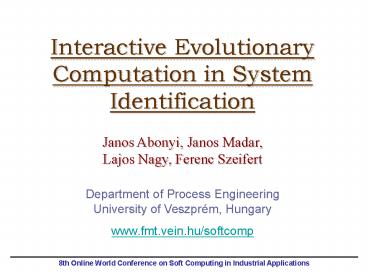Interactive Evolutionary Computation in System Identification - PowerPoint PPT Presentation
1 / 10
Title:
Interactive Evolutionary Computation in System Identification
Description:
8th Online World Conference on Soft Computing in Industrial Applications ... N(0,z): random number, normal. distribution with z deviation ... – PowerPoint PPT presentation
Number of Views:52
Avg rating:3.0/5.0
Title: Interactive Evolutionary Computation in System Identification
1
Interactive Evolutionary Computation in System
Identification
Janos Abonyi, Janos Madar,Lajos Nagy, Ferenc
Szeifert
Department of Process EngineeringUniversity of
Veszprém, Hungary www.fmt.vein.hu/softcomp
2
Contents
- Multi Objective System Identification
- Interactive Evolutionary Computation (IEC)
- Evolutionary Strategy (ES)
- Matlab IEC
- Application Example
- Results
- Conclusions
3
Multi Objective System Identification
The original goals do not often meet
The objectives are often inconsistent
Difficult to formalize
Cost function
OptimizationDifficult to obtain global minima
Solution
4
Evolutionary Algorithms
The EAs are stochastic optimization algorithms
that mimic the process of natural selection.
The EAs handle several candidate solutions
simultaneously (population). These candidate
solutions referred to as individuals. Every
individual represents a point in the search
space. Likes in the natural world, the more
successful individuals, which have bigger fitness
values, have higher probability to transmit their
genes into the new generation. The next
generation of individuals is generated from the
actual population using selection, mutation,
crossover.
Initial population(first generation)
Calculate fitness values(basis on objectives)
Selection
Crossover and Mutation
New generation
End
5
Interactive Evolutionary Computation
The IEC is a technique from the class of
evolutionary algorithms, in which the fitness
function is replaced by a human user.
- The idea is using human intuition as part of
optimization process when - no objective function is mathematically
available, - it is difficult to balance multiple criteria.
Genetic operators
Genetic operators
Genotype
Interface
Selection
Genotype
Phenotype
Phenotype
Fitness
In EC an automated method selects individuals
which constitute the new generation.
In IEC a human user selects individuals which
constitute the new generation.
6
Evolutionary Strategy
The IEC cannot use many individuals and searching
generations because the human fatigue. Hence,
there is a need for an algorithm which can
effectively search with a few individuals within
a few searching generations.
Evolutionary Strategy
The characteristic feature of ES lies in the
self-adaptation of the standard deviation of the
Gaussian distribution used in the mutation. The
basic idea is add these adaptation parameters
(strategy variables) to the genotype, and have
them undergo evolution themselves.
The i-th individual ai (xi,si) xi ? Rn
object variables si ? Rn strategy variables
The mutation xi,j xi,j N(0,si,j) si,j
si,j exp(tN(0,1)tN(0,1)) t, t global
learning rates N(0,z) random number, normal
distribution with z deviation
7
Matlab IEC
The EAsy-IEC Tune Toolbox (www.fmt.vein.hu/softcom
p/EAsy) is designed to be applicable for
different types of optimization problems (e.g.,
system identification, controller tuning, data
mining) in Matlab platform.
On the figure, every column shows the output
realized of the individual which belongs to the
column. These diagrams and numerical values
derive from the genotype and phenotype of the
individual. The operator selects the best
individuals and he/she can define the
parent-pairs of new offspring.
8
Application Example
This example focuses to the identification of the
tendency model of the heating-cooling jacket of a
stirred tank reactor. The identification problem
is identifying the parameters of the tendency
model (gains, time constants, gains, dead-time
and parameters of second order polynomials) from
collected data which were conducted from
open-loop experiments.
9
Results
Model output
Measured output
SQP and IEC
SQP Faster. Automated method. Sensitive to
initial conditions. There is a need for a cost
function. Focuses on only the MSE.
IEC Slower. Not automated method. Not sensitive
to initial conditions. There is no need for a
cost function. Focuses on multiple criteria.
Valve characteristics
10
Conclusions
- System identification problems often result in
multi-objective optimization problems, and in
some cases, the objective functions are
explicitly/mathematically not available. - The IEC allows the process engineer to a
user-guided identification process. - The ES is an effective algorithm for the IEC.
- The IEC is an effective method to handle
multi-objective optimization problems.































